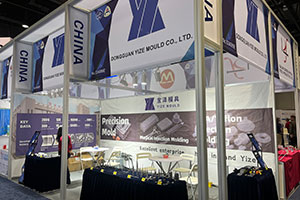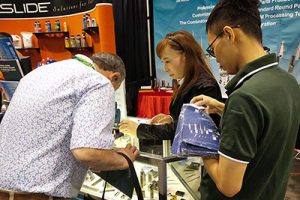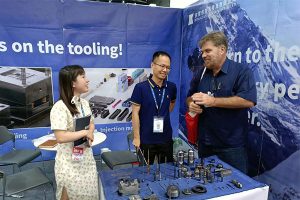Comprehensive Analysis of Safety Operation Procedures in Tungsten Carbide Die Processing
In the vast landscape of modern industrial production, tungsten carbide dies shine like bright stars, occupying a pivotal position. With their exceptional high hardness and high wear resistance, they are […]
In the vast landscape of modern industrial production, tungsten carbide dies shine like bright stars, occupying a pivotal position. With their exceptional high hardness and high wear resistance, they are widely applied in numerous key fields such as metal processing and plastic product molding, providing solid support for the precision manufacturing of various products. However, the processing of tungsten carbide dies is akin to a complex “precision surgery.” Not only is the process intricate, but it also harbors many potential hazards. A single moment of carelessness can lead to safety accidents, posing threats to the life safety of processing personnel and also affecting processing efficiency and product quality. Therefore, formulating and strictly adhering to a set of scientific and comprehensive safety operation procedures is undoubtedly the key to ensuring a safe, efficient, and high-quality processing process. This article will provide a detailed discussion on the safety operation procedures during the processing of tungsten carbide dies.
Before Processing: Taking Precautions to Lay a Solid Safety Foundation
Material Inspection: Strictly Controlling the Source of Quality
Inspecting the tungsten carbide die materials to be processed before starting the work is the top priority. It is essential to ensure that the material quality and dimensions precisely meet the processing requirements, which is the foundation for the smooth progress of subsequent processing. At the same time, carefully check for any surface defects such as cracks and slag inclusions in the materials. These seemingly minor flaws can potentially trigger severe safety accidents during the processing, such as sudden material fractures leading to tool damage or workpiece ejection and injury. Therefore, defective materials must be rejected at the source to eliminate safety hazards.
Our factory business: carbide parts, mold parts, medical injection molds, precision injection molds, teflon PFA injection molding, PFA tube fittings. email: [email protected],whatsapp:+8613302615729.
Equipment Inspection: Ensuring the “Healthy” Operation of Equipment
Processing equipment serves as the “core weapon” in tungsten carbide die processing, and its performance directly impacts the safety and quality of processing. A comprehensive and in-depth inspection of the processing equipment is crucial, covering all aspects such as the precision of the machine tool, lubrication system, cooling system, and electrical system. Only by ensuring that the equipment is in good working condition can accidents caused by equipment failures be avoided. For example, insufficient machine tool precision may lead to significant dimensional deviations in the processed products, affecting die quality. Lubrication system failures can accelerate the wear of equipment components and even cause jamming, posing serious dangers.
Tool Preparation: Selecting the Right “Tools” for Safety
Preparing appropriate tools such as cutting tools, fixtures, and measuring tools according to the processing requirements is a vital step in ensuring processing safety. It is necessary to ensure that the tools are of reliable quality and undergo strict inspection and commissioning before use. The sharpness and integrity of the cutting tools directly affect the processing effect and safety. Dull cutting tools can increase the cutting force, causing excessive equipment vibration and even leading to tool breakage and injury accidents. The clamping effect of the fixtures is also of utmost importance. If the fixtures are loose, the workpiece may move during processing, resulting in collisions and other dangers.
Safety Protection: Building a Comprehensive Safety Net
The processing site should be equipped with complete safety protection facilities, such as protective covers, protective nets, and safety warning signs, to construct a solid physical defense line for processing personnel. At the same time, processing personnel must wear personal protective equipment that complies with regulations, such as safety helmets, protective goggles, and protective gloves, to reduce safety risks at the individual protection level. These protective equipment can effectively block flying debris, prevent head injuries, and protect the eyes and hands from harm, acting as the “guardian angels” for processing personnel.

During Processing: Standardizing Operations and Strictly Adhering to Safety Red Lines
Strictly Abiding by Operation Procedures: Following Rules and Avoiding Violations
Processing personnel must be thoroughly familiar with the operation procedures of the machine tool and strictly follow the prescribed procedures for processing. Arbitrarily changing the processing parameters or engaging in non-compliant operations is like driving recklessly on a highway, which is very likely to cause serious consequences. For example, randomly increasing the cutting speed may cause the cutting tool to overheat and wear out rapidly, and even trigger a fire. Starting or stopping the machine tool without following the proper procedures may damage the equipment or cause personal injuries. Therefore, strictly adhering to the operation procedures is the basic requirement for ensuring processing safety.
Correctly Installing the Workpiece: Precise Positioning and Stable Processing
Accurately placing the tungsten carbide die to be processed on the machine tool worktable and firmly fixing it using fixtures or vacuum chucks is an important step to ensure processing safety. An inaccurately positioned or unstable workpiece is highly likely to move due to vibration during processing, causing collisions between the cutting tool and the workpiece and triggering safety accidents. Therefore, processing personnel should take the workpiece installation process seriously to ensure precise positioning and reliable fixation of the workpiece.
Reasonably Selecting Cutting Tools: Choosing Tools Based on Materials for Safety
Selecting appropriate cutting tools according to the processing requirements and workpiece materials is crucial. The cutting tools should be sharp and free from damage, and they should be firmly installed. During the processing, regularly check the wear condition of the cutting tools and promptly replace those that are severely worn. Worn cutting tools not only affect the processing quality but may also cause unstable cutting forces, leading to increased equipment vibration and higher safety risks. Therefore, reasonable selection and use of cutting tools are key links in ensuring processing safety.
Adjusting Machine Tool Parameters: Scientifically Setting Parameters for Stable Processing
Reasonably adjusting parameters such as the cutting speed, feed rate, and cutting depth of the machine tool according to the processing requirements and workpiece materials is the key to ensuring a stable and efficient processing process. Improper parameter settings, such as an excessively high cutting speed or a large feed rate, may cause the machine tool to overload or operate beyond its capacity, triggering equipment failures or even safety accidents. Therefore, processing personnel should scientifically adjust the parameters based on the actual situation to ensure that the processing process is carried out under safe and stable conditions.
Paying Attention to Cutting Fluid Use: Rational Lubrication and Cooling for Tool Protection
Rational use of cutting fluid during the processing can effectively reduce the cutting temperature and cutting force, improving the processing quality and tool life. Cutting fluid has cooling, lubricating, and cleaning functions, which can reduce the friction between the cutting tool and the workpiece and prevent the cutting tool from overheating and wearing out. At the same time, keep the cutting fluid clean and sufficient, and regularly replace it to avoid affecting the processing effect and equipment life due to contaminated cutting fluid.
Monitoring the Processing Process: Staying Vigilant and Timely Eliminating Risks
During the processing, processing personnel should always stay alert and closely monitor the operating status of the machine tool and the processing effect. Once any abnormal situations are detected, such as abnormal machine tool vibration, unusual sounds, or significant dimensional deviations in the processed parts, immediately stop the machine for inspection and troubleshooting. At the same time, regularly maintain the machine tool to ensure its long-term stable operation. By promptly monitoring and handling abnormal situations, safety accidents can be effectively avoided.
Preventing Flying Debris Injuries: Comprehensive Protection for Safety
A large amount of flying debris, such as chips and powder, is generated during the processing of tungsten carbide dies. These flying debris are like “hidden weapons” that pose threats to the eyes and other parts of processing personnel. Therefore, processing personnel must wear protective goggles and other protective equipment. At the same time, keep the processing site clean and tidy, and promptly clean up the flying debris to prevent secondary accidents caused by debris accumulation, such as slipping.
Avoiding Fire Accidents: Preventing Fires Before They Occur to Ensure Safety
Pay attention to fire safety during the processing. Smoking or using open flames is strictly prohibited at the processing site because the chips and powder generated during the processing of tungsten carbide dies may ignite under certain conditions. Fire extinguishers and other fire-fighting equipment should be equipped around the machine tool, and processing personnel should be familiar with their usage methods to enable timely fire fighting and minimize losses in case of a fire.
After Processing: Meticulous Handling to Ensure Quality and Safety
Post-Processing Treatment: Careful Cleaning and Caring for Dies
After the processing is completed, it is essential to carry out post-processing work such as cleaning and deburring on the tungsten carbide dies. Use appropriate cleaning agents and methods during cleaning to avoid damaging the dies. Be cautious when deburring to prevent damaging the die surface and affecting its quality and service life. Through meticulous post-processing work, the dies can achieve the best working condition.
Quality Inspection: Strictly Checking to Ensure Quality
Conduct a comprehensive quality inspection on the processed tungsten carbide dies, covering aspects such as dimensional accuracy, surface finish, and hardness. Only dies that meet the quality requirements can be put into use. Quality inspection is the last line of defense for ensuring product quality. Any negligence may lead to the entry of non-conforming products into the market, causing losses to the enterprise.
Record Management: Keeping Records for Traceability and Efficiency Improvement
Establish a complete processing record management system to record information such as various parameters during the processing, cutting tool usage, and machine tool operating status. Through record management, problems can be promptly detected and solved, providing references and lessons for subsequent processing. At the same time, record management helps analyze the patterns and problems in the processing process, further optimizing the processing technology and improving processing efficiency and quality.
Conclusion
The safety operation procedures during the processing of tungsten carbide dies are the “amulet” for ensuring the safety of processing personnel, improving processing efficiency, and guaranteeing product quality. By making sufficient preparations before processing, strictly adhering to operation procedures and standardizing operations during processing, carrying out meticulous post-processing and inspection after processing, and establishing a complete record management system, the safety risks during the processing can be effectively reduced, and processing efficiency and quality can be improved. Every processing personnel should keep the safety operation procedures in mind and put them into practice to jointly create a safe, efficient, and high-quality processing environment.
Related Posts
- Tungsten Carbide Die: A Comprehensive Guide to Daily Cleaning and Maintenance
- Selection and Usage Recommendations for Tungsten Carbide Die Cleaning Agents
- How to Maintain the Stability of Tungsten Carbide Dies in High-Speed Cutting
- Application and Effects of Wear-Resistant Coatings on Tungsten Carbide Dies






